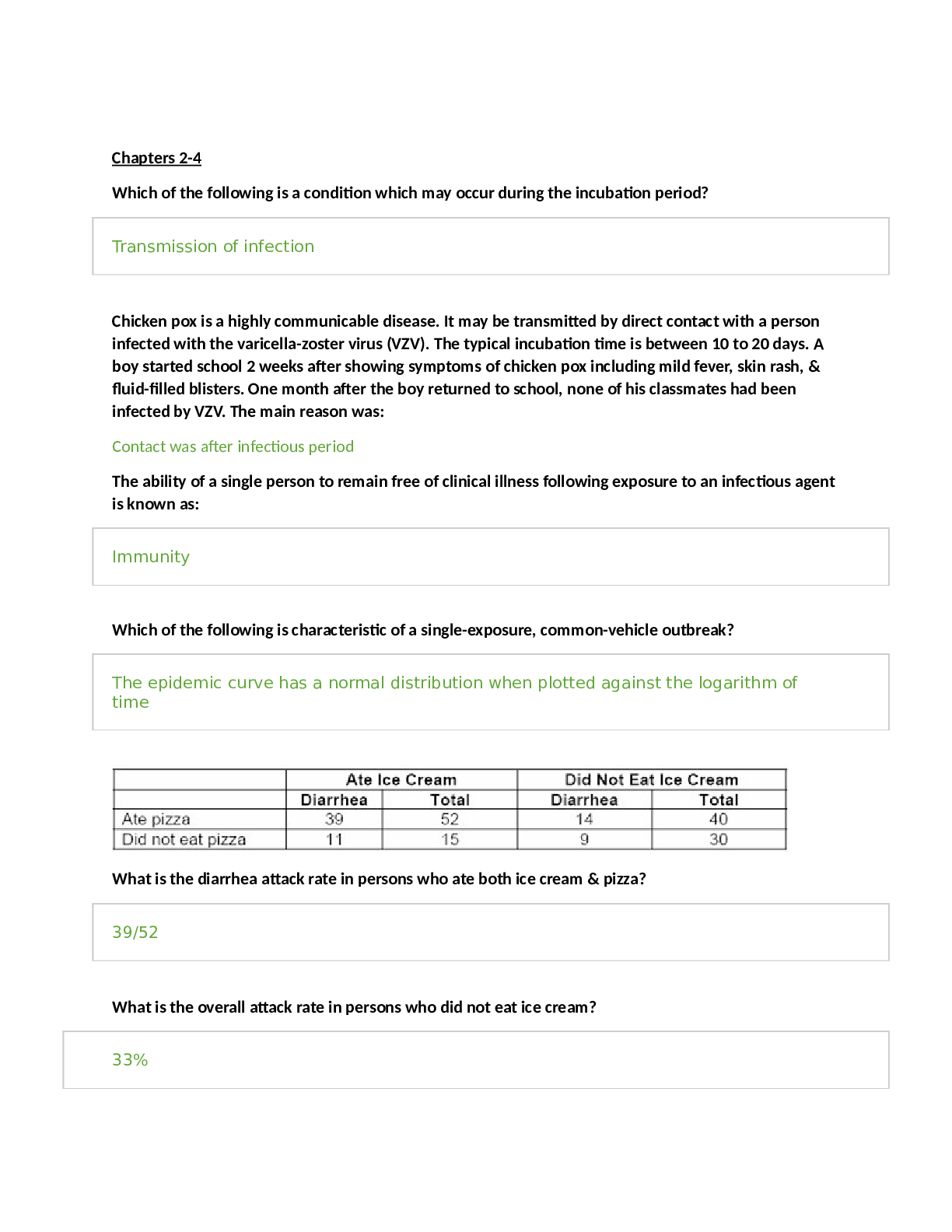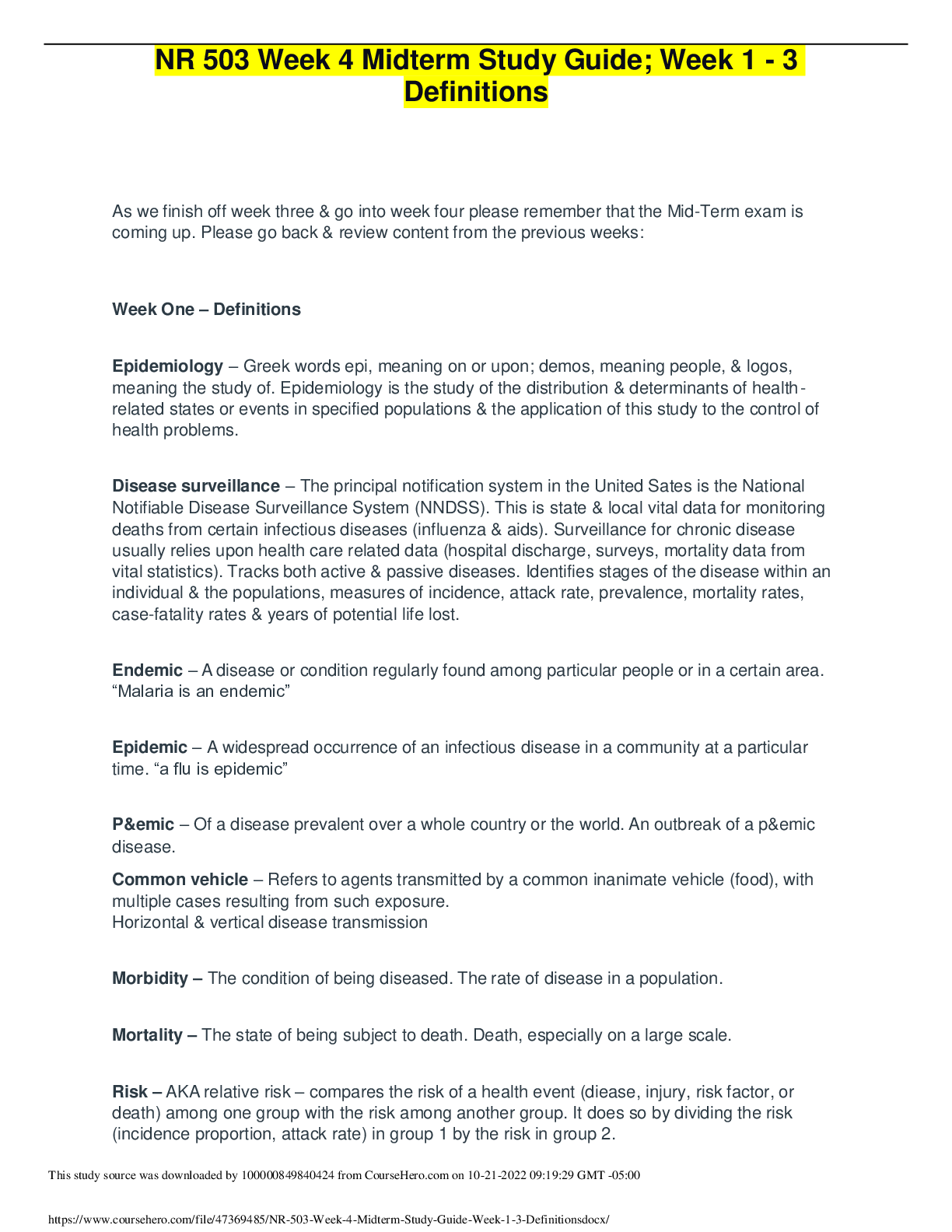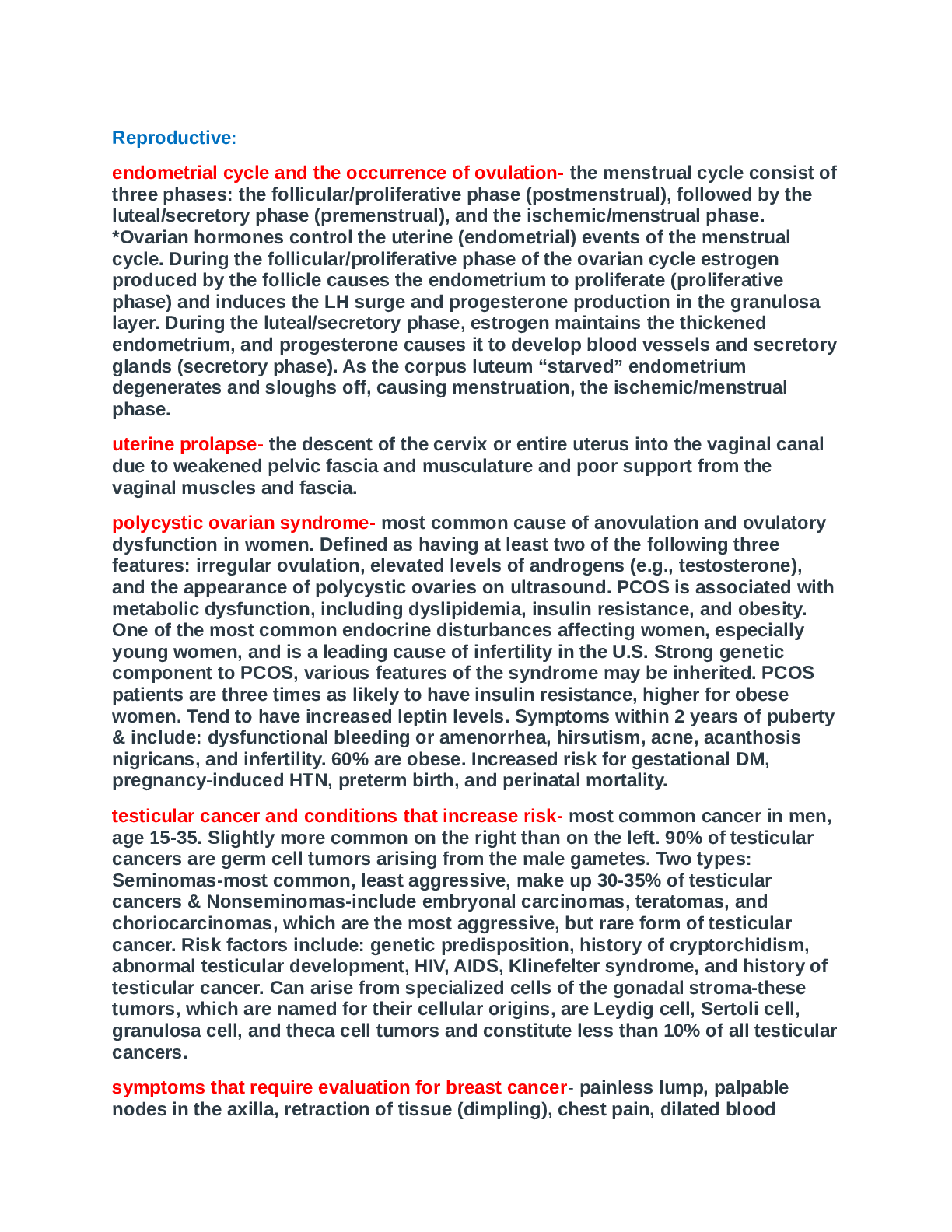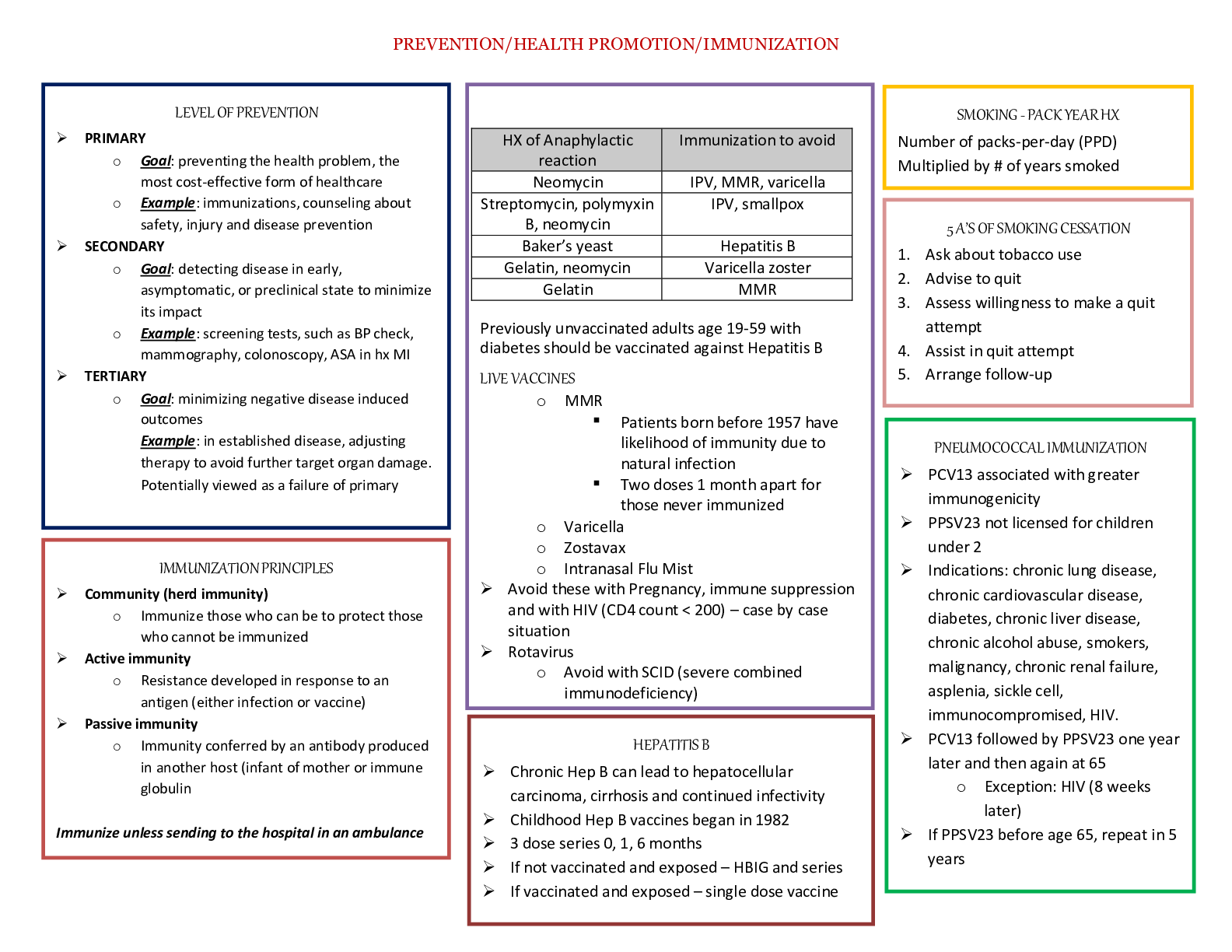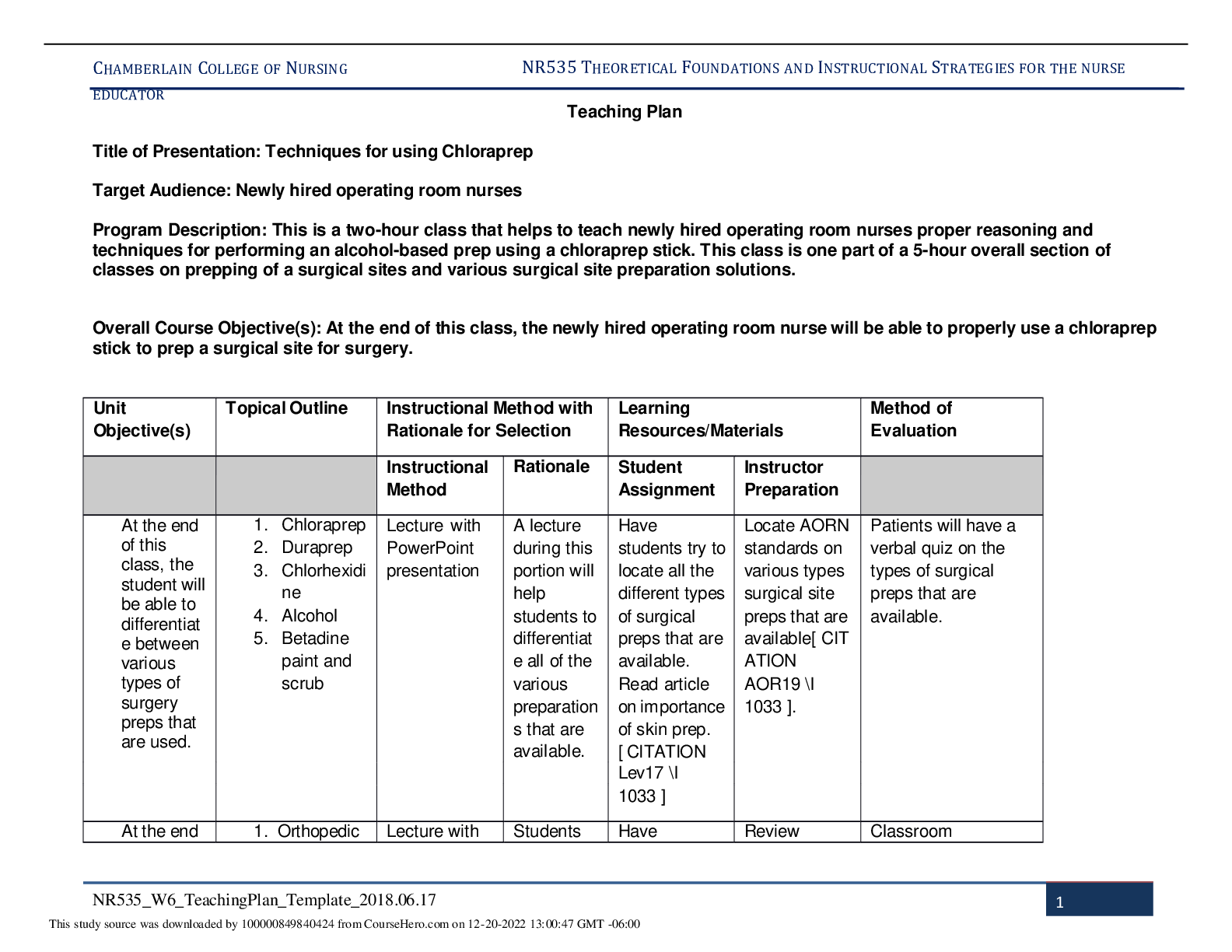Physiology > STUDY GUIDE > PSY 140 life span module 3- Portage Learning (All)
PSY 140 life span module 3- Portage Learning
Document Content and Description Below
PSY 140 life span module 3- Portage Learning The Newborn The smell of a newborn infant. The feel of holding a baby in your arms. Kissing tiny fingers and toes. These are sensations that parents r... elish their entire lives. Many developmental experts note that babies seem to evoke very nurturing responses in most healthy adults, due to their appearance and dependency. A. Infant Reflexes Despite being entirely dependent on caregivers, however, infants do come equipped with reflexes that either help to protect them or enable them to get an early start on motor skills. Each of these reflexes eventually go away when no longer needed. A lingering reflex may indicate brain damage. A list of key infant reflexes is below. See if you know or can guess what the function of each is: Rooting Moro Reflex Grasping Reflex (also known as Palmar grasp) Stepping Reflex Answers: Rooting involves the baby turning her head when her cheek or mouth is touched. It presumably aids feeding as the infant finds something to suck. Moro reflex is a startle response in which the infant arches his back and throws out his arms and legs. The infant behaves much as we would if we felt we were falling and tried to grab something to protect ourselves. Thus, some researchers believe that this reflex has survival value. Most adults know that placing a finger in an infant’s palm will trigger the grasping reflex. This grasp can be extremely strong! This reflex appears to be a stepping stone to additional motor development, as when an infant becomes able to grasp things voluntarily. The stepping reflex involves the infant making stepping motions when held above a surface. Again, it may serve as a building block for future motor development. Please watch the following video that shows and describes infant reflexes: https://youtu.be/0V4x0iQODTk If you are interested in learning more about infant reflexes, you might want to look up these additional ones: Babinski reflex, Tonic Neck, Swimming reflex. B. Sleep and Newborn States Humans at any age go through various sleep/wake states throughout a given day. For example, we may be asleep, fully awake, or drowsy. Similarly, infants move through different states. However, sleep clearly takes up the most time on a newborn infant’s schedule, since newborns typically sleep 16-18 hours per day. When sleeping, infants may be in either nREM sleep or REM sleep. These patterns of infant sleep start developing around 6 weeks of age. Prior to that, infant sleep is highly irregular, both in terms of a lack of clear sleep cycles as well as the heavy amount of baby-REM sleep. When sleeping, infants may be in either nREM sleep or REM sleep. • nREM (non-REM, or non-Rapid Eye Movement; also known as Regular Sleep). This is when the baby is nearly motionless, and is perhaps what the phrase, “sleeping like a baby,” is based on! Non-REM sleep increases as the infant gets older. • REM sleep (also known as Irregular Sleep), characterized by uneven breathing. REM sleep makes up roughly half of an infant’s daily sleep pattern. Infants, unlike adults, begin their sleep cycle in REM sleep. Other infant states include drowsiness and crying. Crying typically peaks at about six weeks of age. It isn’t unusual for infants to cry for 3-4 hours a day at that time. For their own sanity, it’s important for new parents to understand their own emotions when interacting with a crying newborn. It would be better to allow the baby to fuss and cry than for an angry adult to handle a newborn. Shaken baby syndrome can result in brain damage and is caused by an individual very violently shaking a baby, and it is a form of child abuse. Appropriate ways of soothing crying babies include the “5 S’s": • Swaddling (although parents need to be aware of how to safely do this) • Side/stomach position in parent’s arms • Swinging • Sushing sounds • Sucking The “5 S’s” generally work well for the following reasons: 1. Touch is needed for early brain development and physical growth. Touch also releases endorphins to help inhibit pain and increase feelings of calmness. 2. Soothing sound serves as “white noise,” which can be calming. Babies also prefer vocal noises to other noises. 3. Swinging is a very soothing motion. Some theorize that the motion is similar to what the infants experienced in the womb. 4. Swaddling limits overstimulation to the senses. Sometimes new parents become frustrated that nothing seems to calm the child, without realizing that their very efforts might be overstimulating to the infant. Holding the infant in a darkened room that is quiet can also help limit overstimulation. Please watch the following video to see some additional description and demonstration of the 5 S’s: https://youtu.be/vg87nNPdmoQ. Trial and error is needed to see which of these, if any, are what will soothe the baby at that particular moment. There are medical conditions, ranging from minor ailments to more serious ones, that might result in the baby being unable to calm down. In these cases, medical attention might be needed. Assuming all is well with the infant, however, and she is not hungry, cold, or needing to be touched, it’s important to realize that she might just be letting out some steam! Problem Set 1 1. Describe the four infant reflexes discussed in this module. Rooting involves the baby turning her head when her cheek or mouth is touched. The Moro reflex is a startle response in which the infant arches his back and throws out his arms and legs. The grasping reflex involves the infant grabbing something that touches her palm. The stepping reflex involves the infant making stepping motions when held above a surface. 2. Describe the two primary sleep states for infants. nREM is when the baby is nearly motionless, and REM sleep is characterized by uneven breathing. REM sleep makes up roughly half of an infant’s daily sleep pattern. 3. What are the “5 S’s” of infant soothing? Swaddling, Swinging, Sushing, Sucking, Side position Copyright © 2018 Portage Learning. All Rights Reserved. Website by Spire Advertising & Web Design Infancy Watch the video below as you study the material in this module. Infancy is typically defined as occurring during the first two years of life. By age two, infants weigh 30 lbs, on average. Most two-year-olds are between 32-35 inches tall (just shy of 3 feet). To get to this height, infants and toddlers generally grow in spurts (preceded by periods of being very hungry!). Baby fat peaks at about 9 months, and then usually decreases once the infant becomes more mobile. In this section, we will discuss various topics pertaining to infants’ physical growth and development. A. Physical Growth and Development in Infancy There are two types of growth sequences that can be used to describe infant growth patterns: cephalocaudaland proximodistal. These can happen simultaneously, but they help practitioners know what typical patterns of growth to expect in infants. Cephalocaudal means that growth starts at the top, with the head. Looking at the word origin, “Cephalo” refers to the head and “caudal” refers to the tail. You can remember that “cephalo” refers to the head when you think of encephalitis, or inflammation of the head. In normal infant development, the brain and skull is a primary location of growth. Infants’ heads are disproportionately large in comparison to the rest of their bodies. Over time, however, the limbs and other body parts will become primary sites of growth. Infancy is the most rapid and dynamic period of brain development across the lifespan. Although infants are born with all or nearly all of their neurons (cells in the nervous system), infancy is the time where connections are continually made between these neurons. By two years old, infant brains are thickened with dendrites, the tree-like “branches” of neurons. Early childhood, then, is a time of neural pruning, as important connections are maintained and unimportant ones discarded. Please watch this video on prenatal and infant brain development: https://youtu.be/MS5HUDVNbGs Please note some of these key concepts from the video: Overproduction. Infant brains have far more synaptic connections than they need. Once infants start experiencing things in life, their brains start changing in response to what they experience. The used connections are strengthened and stay and the unneeded once are lost, thus pruning these synaptic connections. There are critical periods for some information that we learn. That is, if we don’t learn the information within a specific span of time, our brains won’t develop in the ways that they should. For example, the critical period hypothesis for language says that the first years of life are key for language acquisition. After approximately age 5, a child who experienced extreme deprivation such that he or she never heard human speech most likely will never be able to acquire speech. In contrast, most animal sounds are innate; they will be able to make their respective sounds regardless of hearing other animals like them. An application of the critical period hypothesis can be seen in congenitally deaf children showing vocal deficits because they are unable to hear the sounds. However, if they are exposed to sign language during the critical period, deaf infants can “babble” using sign language! Growth can also be proximodistal. “Proximo” refers to nearness, and “distal” refers to being far away. Thus, “proximodistal” means that growth starts in the center and moves far away. For infants, then, growth will begin in the trunk area and then move to the limbs. For example, gross motor (large muscle) development occurs before fine motor (dexterity) skill development. B. Cognitive Development in Infancy As discussed in Module 1, Jean Piaget developed one of the most important theories of human development. Piaget’s stage theory focused on how people, primarily children, change in their thinking processes over time. His stage for infancy is called the Sensorimotor Stage (Piaget, 1952). However, before we dive into this theory, we first need to discuss some definitions. Scheme (or schema): an organized way of making sense of experience. For example, you have a scheme for “cafeteria” and “soccer team.” These words have meaning to you because you have life experiences that give you detail about each of these concepts. Your scheme for “soccer team,” for example, might include information about the nature of the sport, who plays it, what the field looks like, etc. Essentially, our brains categorize information in particular ways so that we remember concepts. Our schemas can change over time as we incorporate new information and experiences. Piaget clearly emphasized the role of the individual in constructing knowledge. Piaget detailed two principles that govern how schemas change and how cognitive development occurs: Assimilation and Accomodation. Assimilation: New information is taken into existing schemas. Therefore, the information is changed and assimilated as it is brought in. Consider how a common usage of the word, assimilate, means to absorb. In this context, then, information is absorbed into an existing schema. Accomodation: Schemas are changed to make sense of incoming information. Thus, the schemas accommodate the new information. Infants use both processes and may do so simultaneously. Now we are ready to discuss Piaget’s Sensorimotor Stage. As evident in the word itself, this stage involves the infant learning about the world through the senses, and then great gains being made in motor development. With increased mobility come new ways to interact with and learn about the world. 1. Simple Reflexes We have already learned about infant reflexes and how they may serve as building blocks to future motor skills. However, they also serve as building blocks to cognitive gains as well. Behaviors that first occur automatically will eventually become intentional. During this first substage, newborns possess infant reflexes. They behave automatically, without voluntarily deciding to move or act. In later substages, behavior becomes intentional, but it starts out with various movements primarily brought about via reflexes. 2. First habits and primary circular reactions Eventually, the infant reflexes go away, and the infant’s behaviors become more voluntary. For example, sucking starts out as a reflex, but infants eventually learn to suck at will. At this point, behaviors can become habits. For example, now the infant sucks her thumb. Or her toes. Or anything that comes near her mouth! The term, “Primary circular reactions,” simply refers to the baby purposefully trying to reproduce a pleasurable event that occurred by chance. “Primary” means that the infant is the primary object— these first habits are self-focused. The infant isn’t using any toys as tools yet. She only explores her own body parts. 3. Secondary circular reactions Now you have the key to understanding “Secondary circular reactions.” These are purposeful behaviors that are focused on the external world, not just the baby’s body. For example, now an infant can pick up a rattle, shake it, and do so repeatedly. What does this have to do with cognitive development? A lot! That rattle is what the baby is focusing on and thinking about at that moment. He’s learning the sounds that it makes, what it looks like when it moves, and how his hands feel when he’s touching it. This will form his future behaviors and decisions. Also, a Secondary Circular reaction is, in itself, a scheme. In this process, the infant is developing mental representations of how things work. 4. Coordination of secondary circular In this substage, behavior becomes more coordinated and goal-directed. The infant knows what it wants and tries to get it! Much crying may occur if these desires are frustrated. 5. Tertiary Circular Tertiary circular reactions involve the infant experimenting and trying different things. It’s important to note that Piaget, in a way, viewed infants as little researchers. First the infant shakes the rattle, and another time he throws it. Each time he throws it, it lands differently. He keeps throwing it to see what happens. Perhaps this happens at mealtime, with spoons, forks, and food! Also, the infant may now occasionally use a toy as a tool to interact with another toy. “Tertiary” refers to the number 3, incidentally, so this is the third level of experimentation with the world (with Primary Circular and Secondary Circular Reactions being the first two experimental stages). 6. Internalization of schemes The final substage is a very important one. Now the infant can use symbols, or internal representations. The infant can think about an object without seeing the object directly in front of them. This is known as object permanence, or the understanding that an object exists even when it’s out of sight. The game, peek-a-boo, is an excellent test of object permanence. Babies who don’t have object permanence will not try to find the hidden object or face. But, babies who do have object permanence delight in this game; they know that something is hidden, and the popping out of hiding is a great excitement to them! One problem with this final substage is that it is timed at the end of the Sensorimotor Stage. However, most infants achieve object permanence much earlier than this, and some as early as four months! Stop and Think. The Sensorimotor Stage is one of the most complicated theories in this course. It would be a good idea for you to stop reading at this point, and jot down your own summaries of each of the substages of the Sensorimotor Stage before proceeding. You may also want to try to define each of Piaget’s terms discussed in this module. C. Socioemotional Development in Infancy Socioemotional development refers to the social and emotional changes that an individual goes through. Nearly all theories pertaining to infant socioemotional development say that developing close bonds with a caregiver is the primary task of infancy. Before we discuss this, however, we will first explore some more personal characteristics of infants, such as developing a personality. 1. Temperament “Temperament” refers to an individual’s behavioral style and characteristic emotional responses. Temperament is believed to serve as a foundation for adult personality. Three widely accepted types of temperament are: easy children, difficult children, and slow- to- warm- up children (based on Chess & Thomas, 1977; Thomas & Chess, 1991). • Easy children easily establish routines. Parents can easily put them on a schedule, although these children are also adaptable to schedule changes and new experiences. They tend to be fairly happy children. Chess and Thomas (1977) found that approximately 40% of the children they studied would be classified as “easy.” • Difficult children are difficult to put on regular schedules. They tend to be rather unpredictable in mood. They do not adapt well to new people or situations. Typically they react very negatively in novel situations. They may cry frequently and extensively. Chess and Thomas classified 10% of their sample as difficult children. • Slow- to- warm-up children are said to be rather inactive overall. They frequently appear as difficult children do in novel situations, but they are able to adjust (slowly) and improve in mood. However, they tend to not have the consistently positive moods of easy children. Fifteen percent of Chess and Thomas’s sample were slow-to-warm-up. Since Chess and Thomas’s research, additional studies have examined other personality dimensions in infancy and early childhood. D. Attachment Attachment has been a consistent focus in psychology since its founding as a field of study. Attachment refers to a close emotional bond, primarily between a caregiver and a child. Key theorists and researchers who wrote about infant attachment include Sigmund Freud, Harry Harlow, John Bowlby, and Erik Erikson. Specifically, Bowlby’s work greatly influenced research on infant attachment. Like the above theorists, Bowlby said that it is crucial for infants to develop close bonds with caregivers within the first year of life. Failure to do so would result in serious emotional consequences for the infant. Unlike what is sometimes observed in the animal kingdom, human infants take a while to develop attachments. Separation anxiety peaks in infancy, usually between ages 6 and 24 months. Prior to six months, infants typically do not have as strong a bond with their caregivers and may be fine with other sitters caring for them. After this point, however, they may become very upset at separating from their caregivers! These “attachment behaviors” include crying, searching for the parent, reaching toward the parent, and following the parent. This is healthy and normal behavior, according to attachment theorists. Other researchers began with Bowlby’s concepts and developed categories of infants who either develop or do not develop secure attachments with caregivers. Mary Ainsworth is famous for building upon Bowlby's theories and developing an experiment that measures infant attachment. Read about Ainsworth's work at this link in detail and watch the video. Pay careful attention to the categories of infants described. Note that some of the categories have various names (for example, ambivalent/resistant): https://www.simplypsychology.org/mary- ainsworth.html Ainsworth and Bowlby believed that infants who develop secure attachments had caregivers who are appropriately responsive. That is, the parents are tuned to what an infant needs at a given time and are skilled at reading the signals that infants give to indicate their needs. One additional attachment style not mentioned on this site is Disorganized Attachment. Children and infants showing this attachment style show a mix of resistant and avoidant behavior, but are particularly notable for their "dazed and confused" behaviors. They may often appear to be nervous and confused around the caregiver. Some researchers consider this style to be associated with potential child abuse on the part of the caregiver. However, it is important to note that attachment theory is not synonymous with the “pop” psychology movements in recent years that insist that caregivers must remain in constant contact with infants in order to create healthy attachments. Rather than being grounded in psychological theory, so-called "attachment parenting" draws more heavily on observations of some international parenting styles in which infants are constantly wrapped onto the backs and chests of their mother to promote constant physical contact. Cross-cultural research indicates that there is great variation in attachment patterns, and that one size clearly does not fit all when it comes to how parents should interact with their infants. More recent research indicates that healthy parent-child interactions can look different in different cultures. Bowlby's attachment theory, while emphasizing the importance of caregiver- child contact and interaction, does not stipulate that physical contact needs to be constant. Furthermore, bonding does not occur through physical contact alone; appropriate and responsive interactions are key in Bowlby's model. In order to have a well-balanced understanding of attachment, researchers such as Jerome Kagan (2000) help us to see another side to the story. Kagan argues that nature rather than nurture plays a key role. He reminds us that temperament and genetics are crucial in this equation. Some children may do better with less physical contact; others seem to require constant interaction. These needs may have little to do with the behavior of the parents. Thus, it might be unfair to blame parents for a child being insecurely attached, if the child’s behaviors are largely based on temperament, or physical/cognitive/emotional disturbances. For example, a child with autism will perhaps not show secure attachment with a mother; this is not a feature of the mother’s lack of responsiveness but is due to the child’s condition. Problem Set 2 1) Describe the cephalocaudal and proximodistal patterns of physical development. Cephalocaudal growth starts at the head and works toward the limbs and other body parts. Proximodistal growth starts at the trunk and works toward the limbs. 2) If you did not do it earlier, now is the time to define Piaget’s terms using your own words. Then, summarize each substage of the Sensorimotor stage. Do try to define terms in a way that makes sense to you. Then, check your answers against the descriptions in the Cognitive Development section. 3) Describe the three infant temperament types discussed in this module. Easy children establish routines, are generally happy, and easily adaptable. Difficult children are difficult when establishing routines, not adaptable, and often irritable. Slow-to-warm-up children are fairly inactive, and adjust slowly to novel situations. Their moods tend to be not as positive as the easy children, but not as negative as the difficult children. 4) What is attachment? How can you apply what you learned in this module to your understanding of parent-child bonds? Attachment refers to a close emotional bond. Based on what I have learned I can apply it by understanding that all infants are not the same. Figuring out key things such as if the baby requires more touching and being more closer to the baby or less can be applied. Basically, applying the nature vs nurture theory. Copyright © 2018 Portage Learning. All Rights Reserved. Website by Spire Advertising & Web Design Answers to Problem Sets Problem Set 1 1. Rooting involves the baby turning her head when her cheek or mouth is touched. The Moro reflex is a startle response in which the infant arches his back and throws out his arms and legs. The grasping reflex involves the infant grabbing something that touches her palm. The stepping reflex involves the infant making stepping motions when held above a surface. 2. nREM is when the baby is nearly motionless, and REM sleep is characterized by uneven breathing. REM sleep makes up roughly half of an infant’s daily sleep pattern. 3. Swaddling, Swinging, Sushing, Sucking, Side position Problem Set 2 1) Cephalocaudal growth starts at the head and works toward the limbs and other body parts. Proximodistal growth starts at the trunk and works toward the limbs. 2) Do try to define terms in a way that makes sense to you. Then, check your answers against the descriptions in the Cognitive Development section. 3) Easy children establish routines, are generally happy, and easily adaptable. Difficult children are difficult when establishing routines, not adaptable, and often irritable. Slow-to-warm-up children are fairly inactive, and adjust slowly to novel situations. Their moods tend to be not as positive as the easy children, but not as negative as the difficult children. 4) Attachment refers to a close emotional bond. Answers will vary on how to apply this theory. However, good answers will maintain a balance on the nature/nurture debate and how it applies to attachment. Copyright © 2018 Portage Learning. All Rights Reserved. Website by Spire Advertising & Web Design [Show More]
Last updated: 2 years ago
Preview 1 out of 17 pages
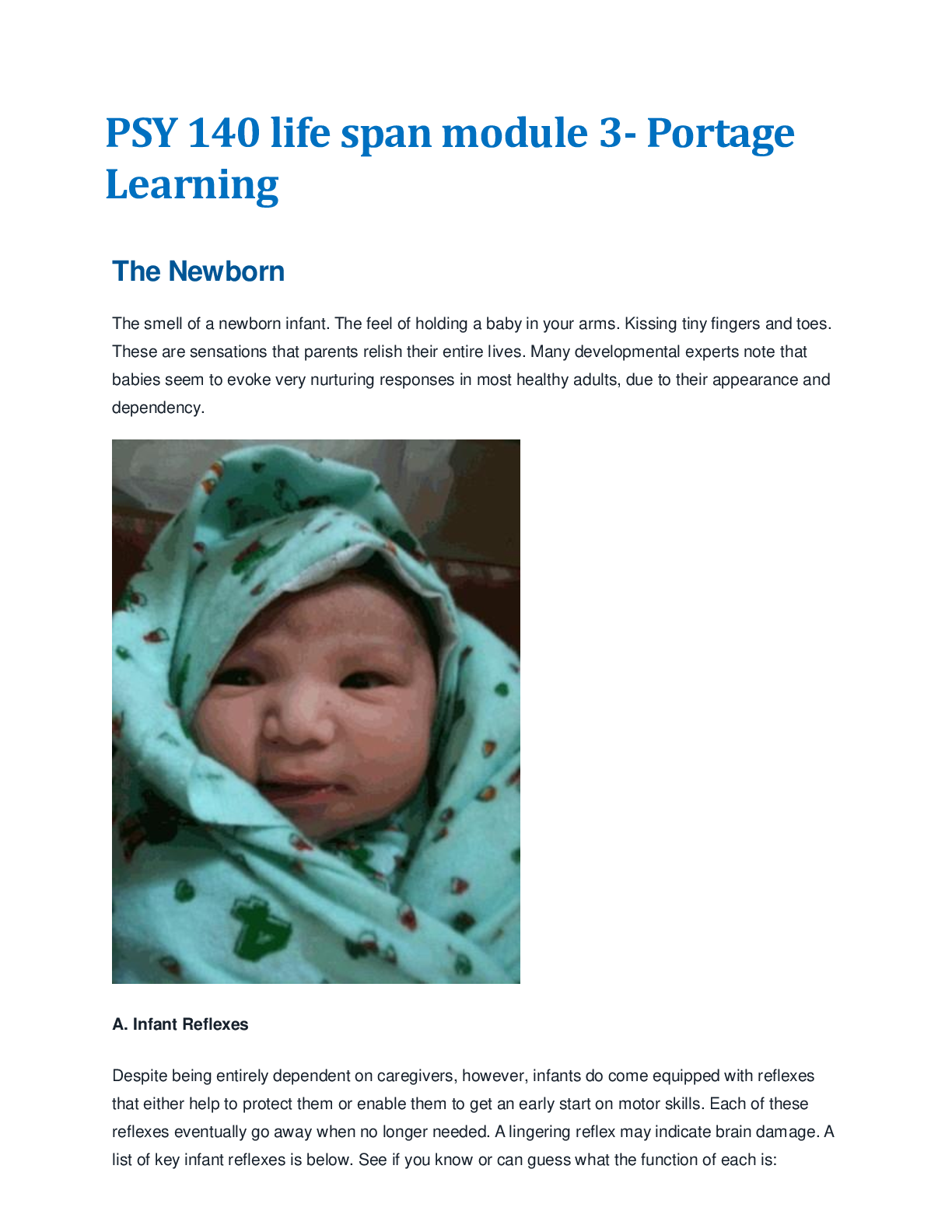
Buy this document to get the full access instantly
Instant Download Access after purchase
Buy NowInstant download
We Accept:

Reviews( 0 )
$14.50
Can't find what you want? Try our AI powered Search
Document information
Connected school, study & course
About the document
Uploaded On
Sep 04, 2021
Number of pages
17
Written in
Additional information
This document has been written for:
Uploaded
Sep 04, 2021
Downloads
0
Views
118


